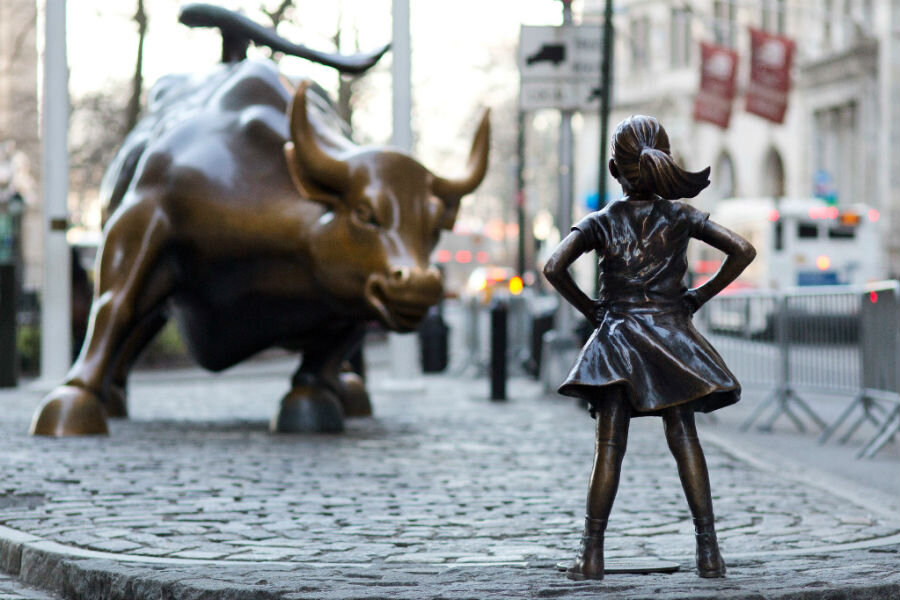Why the 'Fearless Girl' statue will stay put on Wall Street
Loading...
The 50-inch bronze "Fearless Girl" statue, which currently stands in front of Wall Street's famed "Charging Bull" sculpture, will be allowed to stay – at least until February 2018.
The statue was installed on the eve of International Women's Day earlier this month as a commentary on the lack of gender diversity in the workplace. Initially, the statue was supposed to stay facing down the bull for a week, but in light of the popularity of the figure, the permit allowing the temporary art installation to stay was extended until April 2. On Sunday, City Hall announced that New York mayor Bill de Blasio had agreed to allow "Fearless Girl" to remain in position until at least next year.
Despite the statue's growing popularity across the country, many have voiced objections to the "Fearless Girl" sticking around, including Arturo Di Modica, the sculptor who created the "Charging Bull" statue. Critics have called the newer statue a publicity stunt by State Street Global Advisors, a large investment company that commissioned the art installation, saying it unfairly alters the meaning of the world-famous bull sculpture. But many supporters of the "Girl," much like the statue itself, are refusing to back down.
"Works designated as 'Public Art' always have multiple meanings and controversy can follow when additions to the original work are made by later artists," Lynette Bosch, professor of art history at the State University of New York at Geneseo, tells The Christian Science Monitor in an email. "It isn't surprising that such additions increase controversy and evoke critical receptions from the artists who contributed the original work that was changed by an addition."
The "Charging Bull," also known as the "Wall Street Bull" or the "Bowling Green Bull," was installed in 1989, following the 1987 stock market crash, as a symbol of American resilience and ability to rebound in times of struggle. The bronze piece was put in place by Mr. Di Modica without permission, but the striking statue soon gained enough public interest to become a permanent resident of Bowling Green, a small public park in the Financial District of Lower Manhattan. It has since become a tourist attraction and one of the most recognizable symbols of New York's financial district.
In the decades since, however, the 11-foot-tall, 7,100-pound bull has come to represent other things as well. In art, bulls are often associated with themes of masculinity, a fact that does not sit well in a financial atmosphere where only 5.4 percent of Fortune 500 chief executive officers are women. And that's to say nothing of the pro-capitalist sentiments the bull represents for many people, with the sculpture becoming a center for protests during the Occupy Wall Street movement.
"['Fearless Girl'] explodes the idea of the male bullfighter standing in a ring surrounded by assistants and gear and a sword as he displays his courage and, as such, is a spoof on 'machismo' and high-testosterone, ritualistic displays," says Professor Bosch. "In replacing the male bullfighter with the little girl, [artist Kristen] Visbal is witty, satirical, and ironic."
But some have argued that the statue is hypocritical, she adds.
"The statue's feminism has been questioned because it was commissioned by corporate firms which have predominantly male personnel; hence a charge of hypocrisy can be leveled at the commission, as a statue is not enacted corporate policy."
Di Modica has himself dismissed the newer statue as "an advertising trick." Despite how some may interpret her statue, however, Ms. Visbal, a Uruguayan-born American artist, said she had no hard feelings against Di Modica's work.
"I love 'Charging Bull!' " Visbal told The Associated Press on Sunday. "But women are here, and we're here to stay."
But others, including George Speer, an art history professor and director of the Northern Arizona University Art Museum in Flagstaff, say "Fearless Girl" falls a bit short of genuine artistic expression.
"I think the statue's popularity arises from the same properties that exist in 'Charging Bull' – both are instantly legible works that suit the simplistic appetites of the web; and, too, the moment is perfect, when we have an alpha male in the White House who defeated a 'Fearless Woman' of recent political history," Dr. Speer tells the Monitor in an email.
"The 'Fearless Girl' isn't feminist, in my view," he adds. "Feminism in art is a complex, thoughtful engagement with structures of power and language, whether in texts or images. The statue is of little artistic value and will be of only transient interest, serving for the moment to create a meme, an image/idea for a society that has lost its ability to concentrate."
Bosch, however, disagrees.
"The statue has power," she says. "It is a Latina girl defying the establishment that has denied women hiring and power, even as women represent a significant economic force.... Among women, minority women are regularly the most disenfranchised, so 'Fearless Girl' speaks for all women, while reminding the spectator that even the most disenfranchised, minority women can stand their ground."
"This universality within specificity is what has caused 'Fearless Girl' to get so much attention and support and what makes works of art memorable and voices for their time, and across time," she adds.
This article contains material from the Associated Press.








